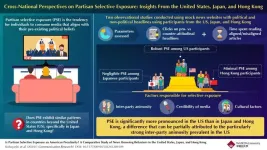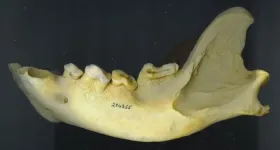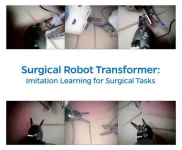(Press-News.org) Highlights:
Delaware watersheds show high microbial impairment.
Researchers collected samples from Delaware waters over 2 years and identified microbial DNA signatures present in the water.
The findings suggest that both treated and untreated human waste are the culprit, likely due to infrastructural issues.
Washington, D.C.—Delaware has numerous inland waterways with high microbial impairment from unknown sources. Now, a new study suggests that human waste, both treated and untreated, is responsible for the waterway impairment in these Delaware watersheds. The study was published in Applied and Environmental Microbiology, a journal of the American Society for Microbiology.
According to the Clean Water Act, when water is contaminated by pollutants and doesn’t meet the standards of clean water, the water bodies are considered impaired. In the new study, researchers worked with the state water quality monitoring staff to collect water across many different locations from 3 different inland watersheds in the southern part of Delaware. They were able to see the microbial communities present in the water by examining the DNA in the water. “The nice thing about this study is that the sampling happened on a monthly basis across 2 different years, 2020 and 2021. We were able to capture a lot of different seasonal, tidal and geographic location differences to look at this in a very comprehensive manner,” said study coauthor Jennifer Biddle, Ph.D., a professor in the School of Marine Science and Policy at the University of Delaware.
The researchers compared the DNA signatures in the water to DNA signatures from a library that contained signatures from many different organisms that live across Delaware, including domestic and livestock as well as human signatures. The researchers found that the majority of the microbial signatures in the water were comparable to a human waste signature and did not match an animal signature, either domestic or agricultural.
“This idea that you live downstream from a cow farm and thus your water is impaired… we never found that being any sort of signature in the water. It was a majority human signature,” Biddle said. The study suggests that the way the microbes are present in the environment are most similar to what is seen from human waste, treated waste and untreated human waste. “With a library of over 10,000 signatures from different microbes, we were able to say that this looks like a human signature instead of a goose signature or some other animal. We don’t have a massive issue with animal inputs in the waterway,” Biddle added. “People might have concerns about migratory geese or agricultural animals, but it seems like that waste isn’t a concern.”
The study indicates that infrastructure type problems may be the cause of water impairment. “We saw a septic system signature in the water,” Biddle said. “We need to look into infrastructure issues and systems that might have been installed a long time ago.” Currently, septic systems in Delaware don’t need to be replaced until a property is sold, but the study suggests that property owners should more frequently make sure their septic systems are up to code.
“Our ability right now to look at the microbiology of an environment with a massive sequencing approach is very useful and has increased in its utility, beyond just examining what the EPA regulations regularly require,” Biddle said.
###
The American Society for Microbiology is one of the largest professional societies dedicated to the life sciences and is composed of over 32,000 scientists and health practitioners. ASM's mission is to promote and advance the microbial sciences.
ASM advances the microbial sciences through conferences, publications, certifications, educational opportunities and advocacy efforts. It enhances laboratory capacity around the globe through training and resources. It provides a network for scientists in academia, industry and clinical settings. Additionally, ASM promotes a deeper understanding of the microbial sciences to diverse audiences.
END
Inland Delaware watersheds impaired by human waste
2024-11-11
ELSE PRESS RELEASES FROM THIS DATE:
Study on the ideas and methods of bloodletting therapy in the treatment of heat stroke
2024-11-11
Heat stroke is primarily classified into exertional and non-exertional forms. Exertional heat stroke results from strenuous physical activity in high heat, while non-exertional heat stroke typically affects those exposed to extreme heat without engaging in significant physical exertion. Symptoms include elevated body temperature, impaired consciousness, headaches, muscle spasms, and, in severe cases, cardiovascular overload, cerebral hypoxia, and organ failure. Western medicine’s primary treatments include cooling methods, rehydration, and pharmacological interventions like dexamethasone ...
New measures of patient well-being can be applied readily in clinical care
2024-11-11
Waltham — November 11, 2024 — Two measures of patient well-being, designed for use in busy clinical settings, are described in a Perspective piece in a supplement to Medical Care, the official journal of the Medical Care Section of the American Public Health Association. The journal is published in the Lippincott portfolio by Wolters Kluwer. The journal is published in the Lippincott portfolio by Wolters Kluwer.
The Medical ...
New study links historical redlining to delays in HIV treatment
2024-11-11
A new study from Tulane University finds that historical race-based lending practices are still impacting health today, linking these discriminatory policies to delays in effective HIV treatment within affected neighborhoods.
The lending practice, called redlining, was abolished in 1968. Yet, those living in once historically redlined neighborhoods experience 15% longer delays in achieving viral suppression of HIV compared to those in non-redlined areas, according to the study published in JAMA Internal Medicine.
The disparity can impact both individual ...
Understanding causes of echo chambers: Political news selective exposure across countries
2024-11-11
In our digital age, with easy access to a vast array of information, one would think that readers would naturally be exposed to a wide range of perspectives. However, the opposite seems to be happening, especially in countries like the United States (US), where people often seek out news that reinforces their existing beliefs and avoid content that challenges them. This tendency, known as partisan selective exposure, has been linked to increasing divides and tensions between different ideological groups. But is ...
New study reveals unique adaptations of jaw function and tooth wear in hypercarnivores
2024-11-11
A new study led by Dr. Jack Tseng and published in PeerJ Life & Environment has shed light on the intricate relationship between tooth wear and jaw mechanics in highly carnivorous mammals, known as hypercarnivores. As mammalian teeth do not regenerate, these animals often face declining bite efficiency as their teeth wear down over time. This research explores how different hypercarnivorous species, including scavengers, meat specialists, and bone-cracking predators, adapt biomechanically and possibly behaviorally to manage the challenges posed by tooth wear.
The ...
Robot that watched surgery videos performs with skill of human doctor
2024-11-11
A robot, trained for the first time by watching videos of seasoned surgeons, executed the same surgical procedures as skillfully as the human doctors.
The successful use of imitation learning to train surgical robots eliminates the need to program robots with each individual move required during a medical procedure and brings the field of robotic surgery closer to true autonomy, where robots could perform complex surgeries without human help.
“It’s really magical to have this model and all we do is feed it camera input and it can predict the robotic ...
“Emotional contagion” a factor in senior’s mental health
2024-11-11
Madeleine and Paul are sitting on a park bench. As she tells Paul about her financial worries and how she’s been struggling for months to make ends meet, Madeleine’s eyes well with tears. Paul is moved by her distress; her woes resonate with him and heighten his own fears. His heart grows heavy and his own eyes become moist, too.
What’s going on? A kind of behavioural mirroring, what psychologists call “emotional contagion.”
“Just as some people are more likely to catch a respiratory virus through close contact, others are more susceptible to ‘catching’ the emotions of the people around them,” explained Marie-Josée ...
Fear of another heart attack may be a major source of ongoing stress for survivors
2024-11-11
Research Highlights:
Fear of another heart attack was a significant ongoing contributor to how heart attack survivors perceive their health, according to a new study.
While anxiety and depression are recognized as common conditions after a heart attack, they did not explain the impact of fear of recurrence in this study.
The researchers suggest that fear of another heart attack should be evaluated and addressed separately from depression and anxiety.
Note: The study featured in this news release is a research abstract. Abstracts presented at the American ...
Let’s talk about sex: Heart patients want guidance from health care professionals
2024-11-11
Research Highlights:
A small survey of adults aged 30 to 89 (average age of 65) in Sweden who have heart conditions found that there is a significant difference between the sexual health information they seek and what is provided to them by their health care professionals and the health care system.
Despite 76% of patients with heart conditions reporting that sexual health affects their mood and well-being, only 5% received information or counseling about sexual health.
Researchers suggest health care professionals adjust their patient care practices to ensure that discussing sexual health becomes a standard and respected topic in health ...
Heart disease more common in past redlined areas linked to limited access to healthy foods
2024-11-11
Research Highlights:
Heart disease, Type 2 diabetes, high blood pressure and obesity were more common and linked to reduced access to healthy food among people who lived in neighborhoods previously subjected to structural racism-based policies that limited home ownership — an outlawed practice known as redlining.
Researchers say testing interventions to help improve access to healthy food or boost social and economic resources could mitigate the still-present impact of outdated policies like redlining.
Note: The study featured in this news release is a research abstract. Abstracts presented at American Heart Association’s scientific meetings are not peer-reviewed, and the ...


